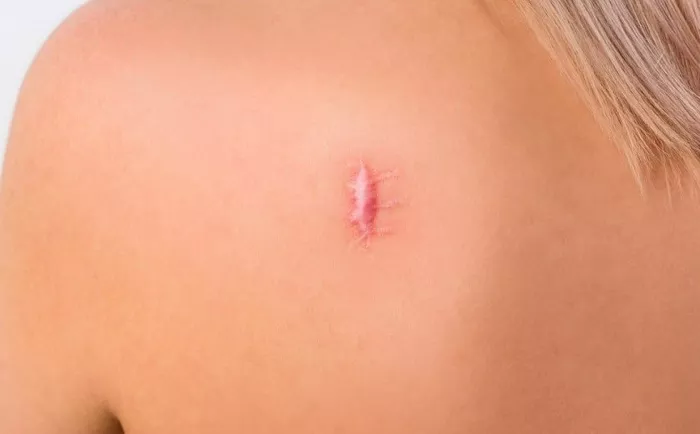Scars are a natural part of the healing process after an injury or surgery. While scars may fade over time, some scars may be permanent. Knowing if a scar is permanent can help you determine the best course of treatment. In this article, we will discuss how to know if a scar is permanent and what to look for when evaluating a scar.
Appearance of the Scar
The appearance of the scar is one of the most significant indicators of whether a scar is permanent or not. A permanent scar is typically thicker, raised, and more noticeable than a temporary scar. Permanent scars may also have a different texture than the surrounding skin and may appear shiny or glossy.
Temporary scars, on the other hand, are usually flat and less noticeable than permanent scars. Temporary scars may also have a similar texture to the surrounding skin and may fade over time.
If a scar is still visible after several months, it’s likely that the scar is permanent. However, it’s essential to consult with your doctor to determine the best course of treatment for the scar.
Age of the Scar
The age of the scar is another important factor in determining if a scar is permanent. Scars that are less than six months old are still in the healing process and may fade over time. These scars are typically red or pink in color and may be raised or thick.
Scars that are older than six months are more likely to be permanent. These scars may have a different texture than the surrounding skin and may be thicker or raised. Older scars may also have a white or silver color and may be less noticeable than newer scars.
If a scar is older than six months and still visible, it’s likely that the scar is permanent. However, it’s essential to consult with your doctor to determine the best course of treatment for the scar.
Location of the Scar
The location of the scar is another factor in determining if a scar is permanent. Scars that are located on areas of the body that are constantly in motion, such as the hands or feet, may be more likely to be permanent. These scars are subject to more stress and tension, which can make them more noticeable and harder to treat.
Scars that are located on areas of the body that are less mobile, such as the chest or back, may be less likely to be permanent. These scars are subject to less stress and tension, which can make them easier to treat.
If a scar is located on an area of the body that is constantly in motion and still visible after several months, it’s likely that the scar is permanent. However, it’s essential to consult with your doctor to determine the best course of treatment for the scar.
Type of Scar
The type of scar is another factor in determining if a scar is permanent. There are several types of scars, including keloid scars, hypertrophic scars, and atrophic scars.
Keloid scars are thick, raised scars that extend beyond the area of the original injury. These scars may be red or pink in color and may be itchy or painful. Keloid scars are more likely to be permanent and may require specialized treatment.
Hypertrophic scars are similar to keloid scars but do not extend beyond the area of the original injury. These scars may be red or pink in color and may be raised or thick. Hypertrophic scars are more likely to be permanent than other types of scars.
Atrophic scars are scars that appear sunken or depressed in the skin. These scars may be caused by acne, injury, or surgery. Atrophic scars are typically less noticeable than other types of scars but may still be permanent.
If a scar is a keloid or hypertrophic scar, it’s more likely to be permanent. However, it’s essential to consult with your doctor to determine the best course of treatment for the scar.
Treatment Options for Permanent Scars
If a scar is determined to be permanent, there are several treatment options available to help reduce the appearance of the scar. Some of the most common treatments for permanent scars include:
Topical Treatments
Topical treatments, such as silicone gels or creams, can help to reduce the appearance of scars. These treatments work by hydrating the skin and reducing inflammation, which can help to improve the overall texture of the scar.
Steroid Injections
Steroid injections can be used to reduce the size and thickness of keloid or hypertrophic scars. These injections work by reducing inflammation and slowing down the production of collagen in the scar tissue.
Laser Therapy
Laser therapy can be used to reduce the appearance of scars by removing the top layer of skin and stimulating the production of collagen. This can help to improve the overall texture of the scar and make it less noticeable.
Surgical Scar Revision
Surgical scar revision involves removing the scar tissue and replacing it with healthy skin. This procedure can be used to improve the appearance of scars that are large or located in areas of the body that are difficult to treat with other methods.
Conclusion
In conclusion, there are several factors to consider when determining if a scar is permanent. The appearance of the scar, the age of the scar, the location of the scar, and the type of scar are all important factors to consider. If a scar is still visible after several months, it’s likely that the scar is permanent. However, it’s essential to consult with your doctor to determine the best course of treatment for the scar. With the right treatment and care, even permanent scars can be minimized and become less noticeable over time.
[inline_related_posts title=”You Might Be Interested In” title_align=”left” style=”list” number=”6″ align=”none” ids=”4108,4106,4104″ by=”categories” orderby=”rand” order=”DESC” hide_thumb=”no” thumb_right=”no” views=”no” date=”yes” grid_columns=”2″ post_type=”” tax=””]































